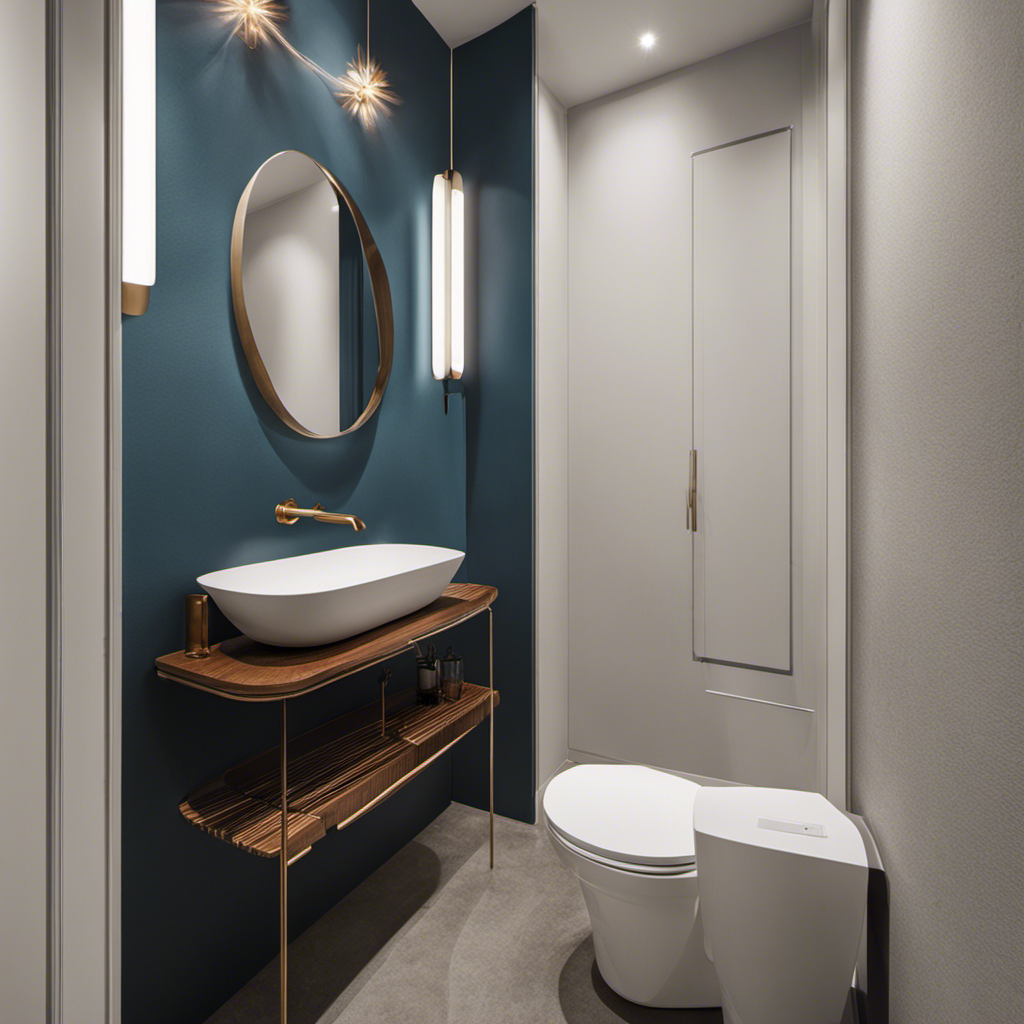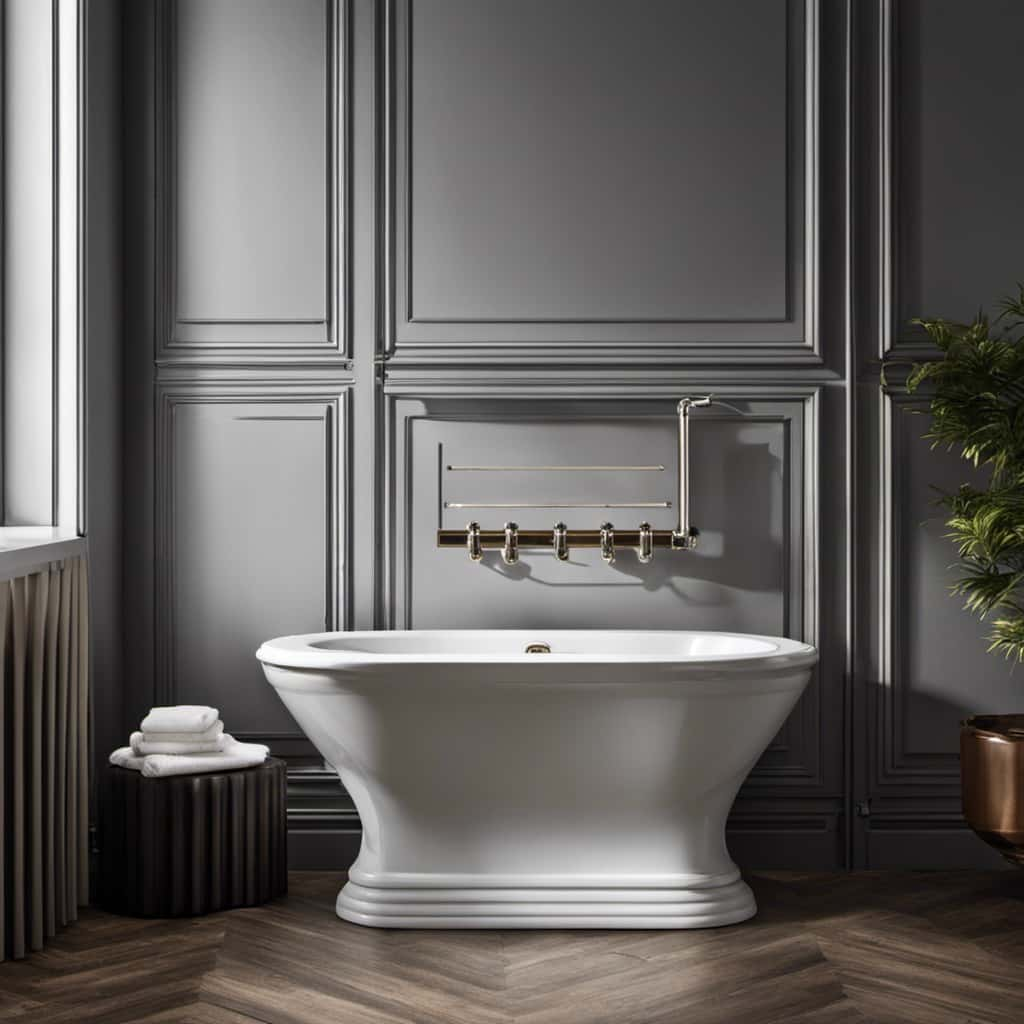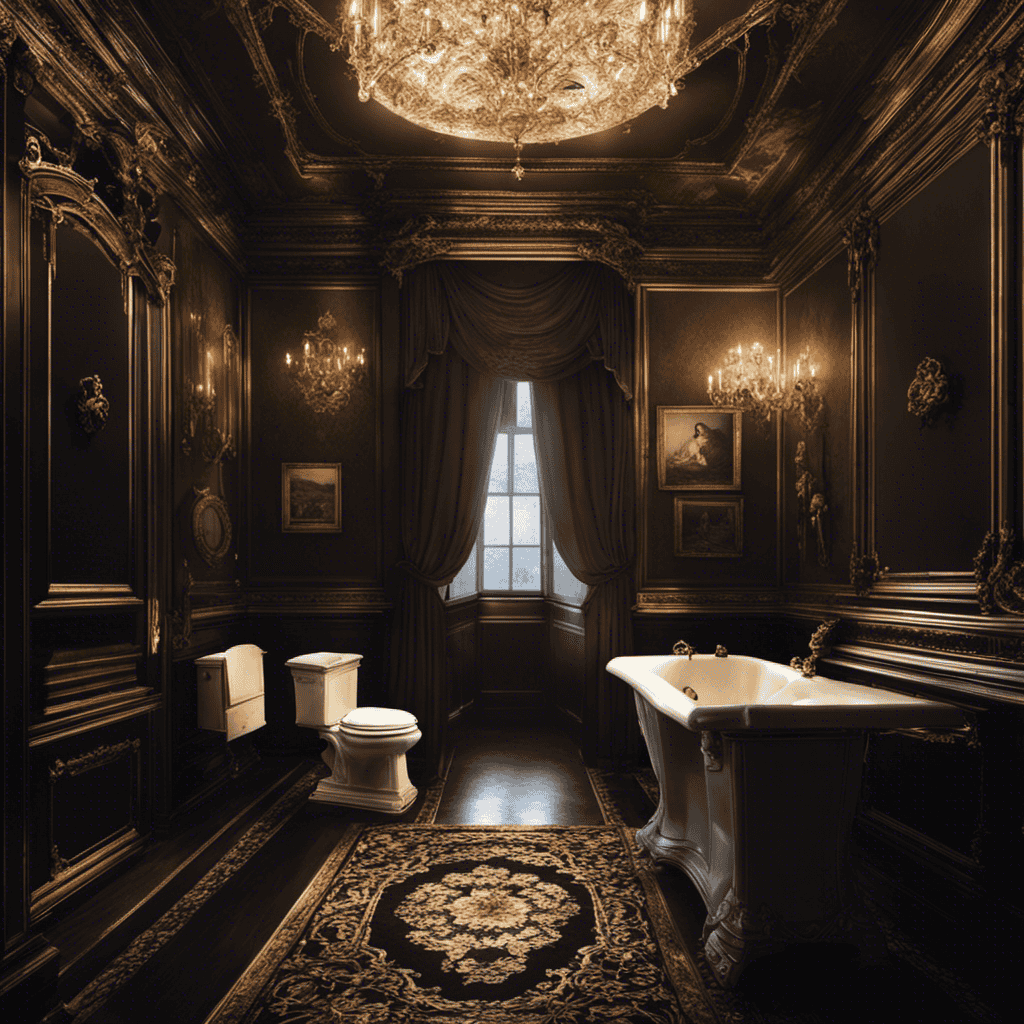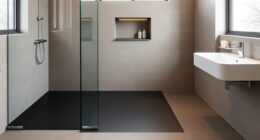Painting behind a toilet can seem as tricky as fitting a square peg into a round hole. But fear not, my friends! I’ve got the step-by-step guide that will make this daunting task a breeze.
With just a few tools and some patience, you’ll be able to transform that neglected space into a work of art. So grab your paintbrush and let’s dive right in!
Key Takeaways
- Preparation is key: Clean the area thoroughly before starting the painting process, paying special attention to the base and back of the toilet.
- Properly remove the toilet tank: Turn off the water supply, flush the toilet, and unscrew the supply line and bolts/screws to lift the tank straight up and set it aside.
- Use the right tools and techniques: Cover the toilet with plastic, apply a bathroom wall primer, and use a small roller or brush to reach all corners and edges.
- Reassemble with care: Clean the toilet, place a wax ring on the flange, lower the toilet bowl onto it, align the bowl with the bolts, tighten the nuts, attach the tank, and connect the water supply.
Tools and Materials Needed
You’ll need a paintbrush, a small roller, a drop cloth, and some painter’s tape to get started on painting behind a toilet.
When choosing the right paint color, it’s important to consider the overall color scheme of your bathroom. Neutral tones like white or beige can create a clean and timeless look, while bold colors can add a pop of personality.
Now, before you begin painting, it’s essential to protect the toilet from any accidental drips or splatters. To do this, cover the toilet bowl with a plastic bag or garbage bag and secure it with painter’s tape. This will ensure that no paint gets on the toilet and makes the whole process much easier.
Now that you have your tools ready and the toilet protected, let’s move on to preparing the area.
Preparing the Area
Make sure to thoroughly clean the area around the toilet before beginning the painting process. Cleaning the area is an important step to ensure a smooth and long-lasting paint job. Here are some protective measures you can take and steps to follow when cleaning the area:
- Wear gloves and protective eyewear to avoid contact with any cleaning chemicals.
- Use a mild detergent or disinfectant to clean the toilet and surrounding area.
- Pay special attention to the base and back of the toilet, as these areas can accumulate dust and grime.
- Use a scrub brush or toothbrush to scrub away any dirt or stains.
- Rinse the area with clean water and dry it thoroughly before starting the painting process.
Removing the Toilet Tank
To remove the toilet tank, start by turning off the water supply and flushing the toilet to empty the tank. This is an essential step before attempting any toilet tank replacement or troubleshooting toilet leaks.
Once the tank is empty, locate the water supply valve near the wall behind the toilet and turn it clockwise to shut off the water.
Next, unscrew the supply line from the bottom of the tank using an adjustable wrench. Be sure to have a bucket or towel handy to catch any remaining water in the line.
After disconnecting the supply line, remove the bolts or screws that secure the tank to the bowl. Carefully lift the tank straight up and set it aside. Remember to be cautious as the tank can be heavy.
Now that the tank is removed, you can proceed with your desired repairs or painting.
Painting the Area Behind the Toilet
Once the tank is removed, it’s important to prepare the area for painting by cleaning and sanding the wall surface. This ensures that the paint adheres properly and gives you a smooth, professional-looking finish.
Here are some tips for achieving a seamless paint finish behind a toilet:
- Protect the toilet: Cover the entire toilet with plastic or a drop cloth to prevent any accidental paint splatters or drips.
- Use a primer: Apply a primer specifically designed for bathroom walls to create a good base for the paint and prevent any moisture or stains from seeping through.
- Use the right tools: A small roller or brush is best for painting in tight spaces behind the toilet. Make sure to reach all the corners and edges for a thorough coverage.
Common mistakes to avoid when painting behind a toilet:
- Rushing the prep work: Take the time to clean and sand the wall properly to ensure a long-lasting finish.
- Not using a primer: Skipping this step can result in peeling or uneven paint.
- Overloading the brush or roller: Apply thin, even coats of paint to prevent drips and streaks.
Reassembling the Toilet and Final Touches
Now that the wall is properly painted, it’s time to reassemble the toilet and add the final touches. To ensure a clean and well-maintained toilet, it’s important to follow a few steps.
First, clean the toilet thoroughly using a toilet cleaner and a brush. Pay special attention to the bowl, rim, and under the seat.
Once the toilet is clean, it’s time to reassemble it. Start by placing the wax ring on the flange, ensuring it is centered properly. Carefully lower the toilet bowl onto the wax ring and align it with the bolts. Tighten the nuts on the bolts to secure the toilet.
Finally, attach the tank to the bowl and connect the water supply. Give the toilet a final clean and flush to ensure everything is working properly.
With these steps, your toilet will be clean, well-maintained, and ready for use.
Frequently Asked Questions
Can I Use Regular Wall Paint to Paint Behind a Toilet?
Yes, regular wall paint can be used to paint behind a toilet. However, it’s important to use painting techniques for hard to reach areas and choose the best paint colors for small bathrooms to ensure a professional and durable finish.
How Long Should I Wait for the Paint to Dry Before Reassembling the Toilet?
I usually wait at least 24 hours for the paint to dry before reassembling the toilet. This allows ample time for the paint to fully cure and prevents any smudging or damage during the reassembly process.
Can I Paint Behind a Toilet Without Removing the Toilet Tank?
Yes, you can paint behind a toilet without removing the tank. It requires using specific painting techniques like using a small brush or roller, and protecting the tank with plastic. There are alternative solutions, but this method is practical and efficient.
Should I Use a Primer Before Painting Behind a Toilet?
Should I use a primer before painting behind a toilet? Yes, using a primer is necessary as it helps the paint adhere better and provides a smooth finish. Alternatives like self-priming paints may work, but primer is recommended for best results.
Can I Use a Roller Brush to Paint Behind a Toilet, or Is a Paintbrush Recommended?
I prefer using a paintbrush when painting behind a toilet because it allows for more precision and control. However, if space is limited, a roller brush can be used with caution. Always use drop cloths and tape for protection.
Conclusion
In conclusion, painting behind a toilet may seem like a daunting task, but with the right tools and preparation, it can be easily accomplished. By taking the necessary steps to remove the toilet tank and protect the surrounding area, you can ensure a smooth and professional finish.
Remember to use a high-quality paint that is resistant to moisture and mildew. With a little patience and attention to detail, you can transform your bathroom into a stylish and refreshed space.
So, don’t be afraid to tackle this project and enjoy the satisfaction of a job well done.










